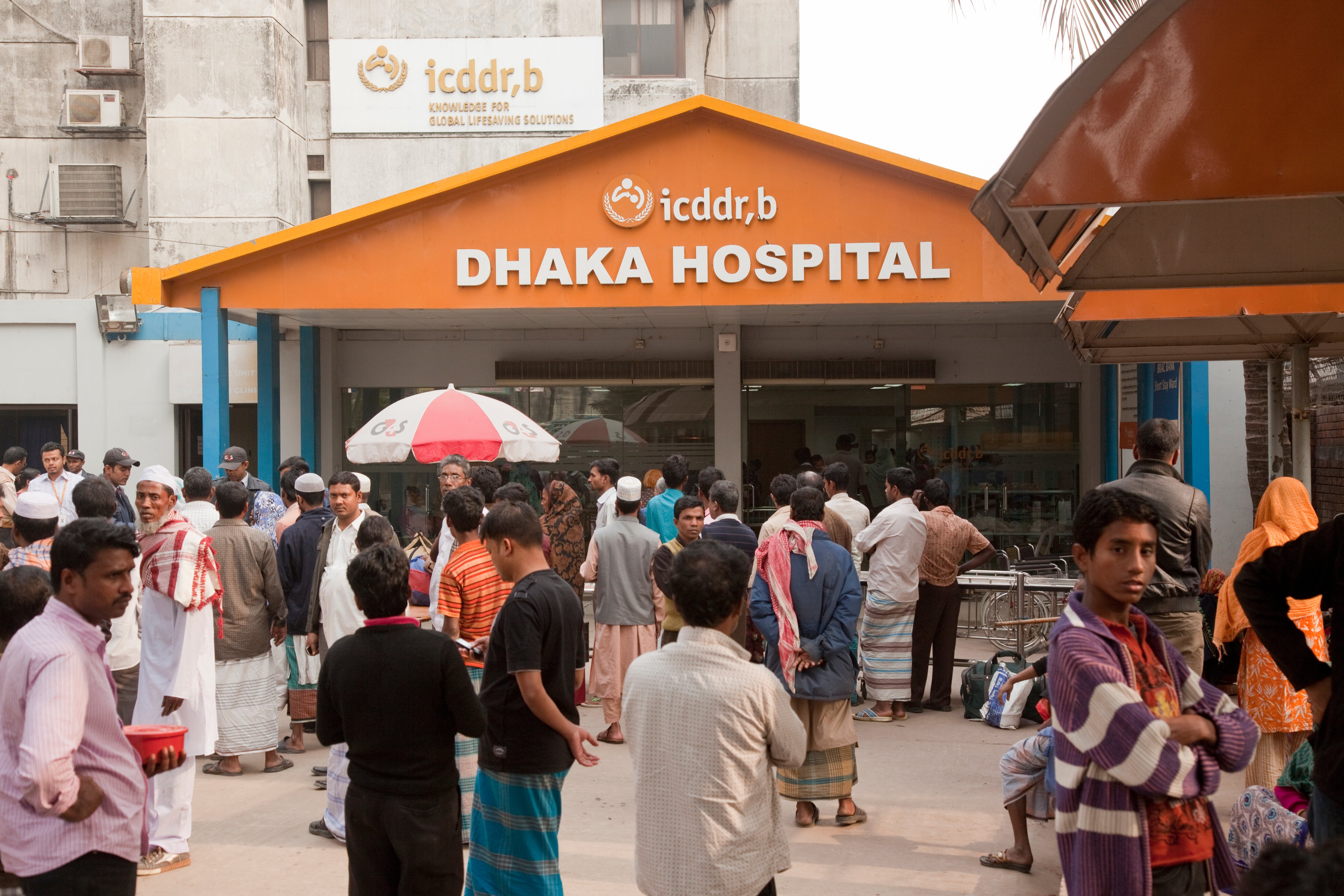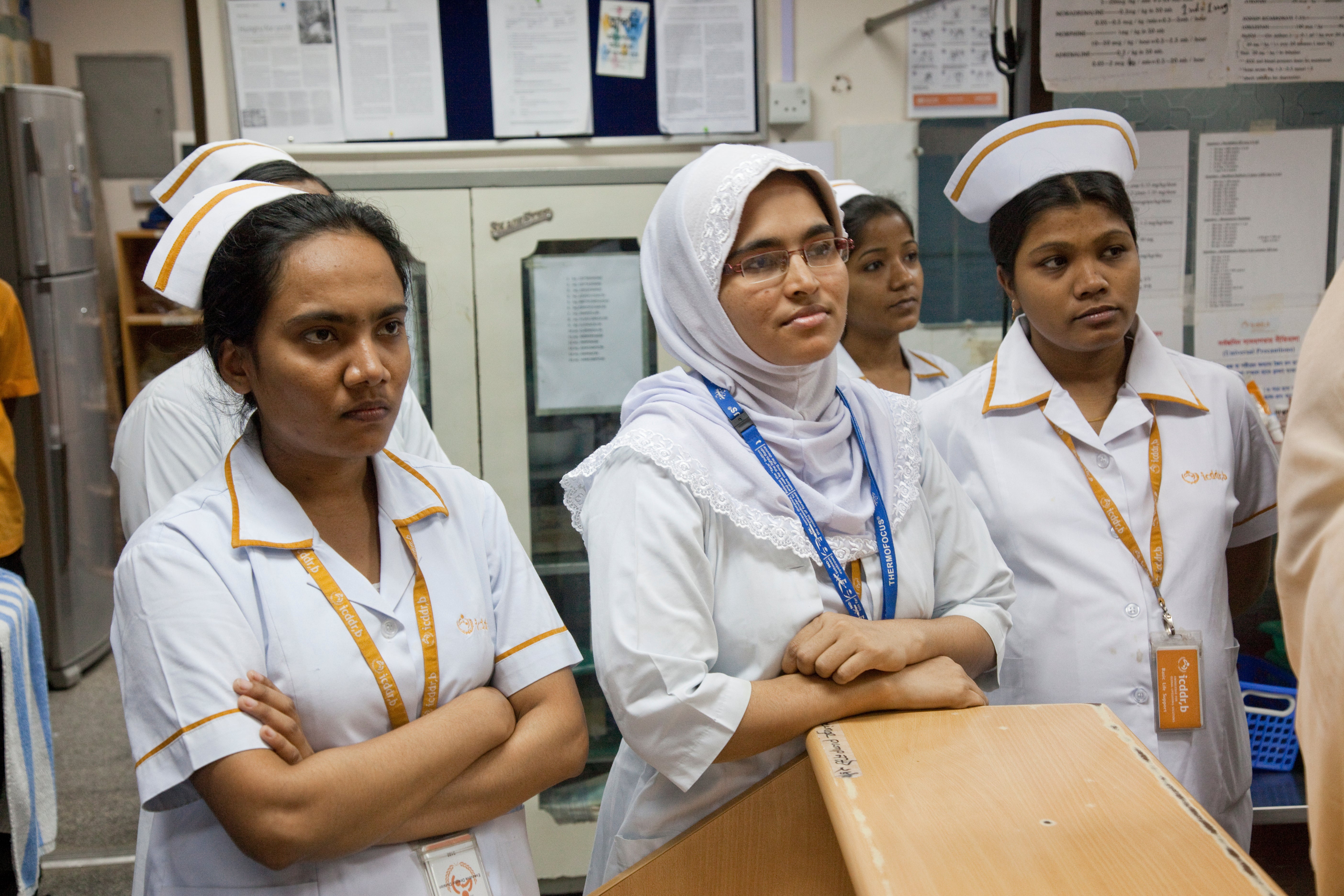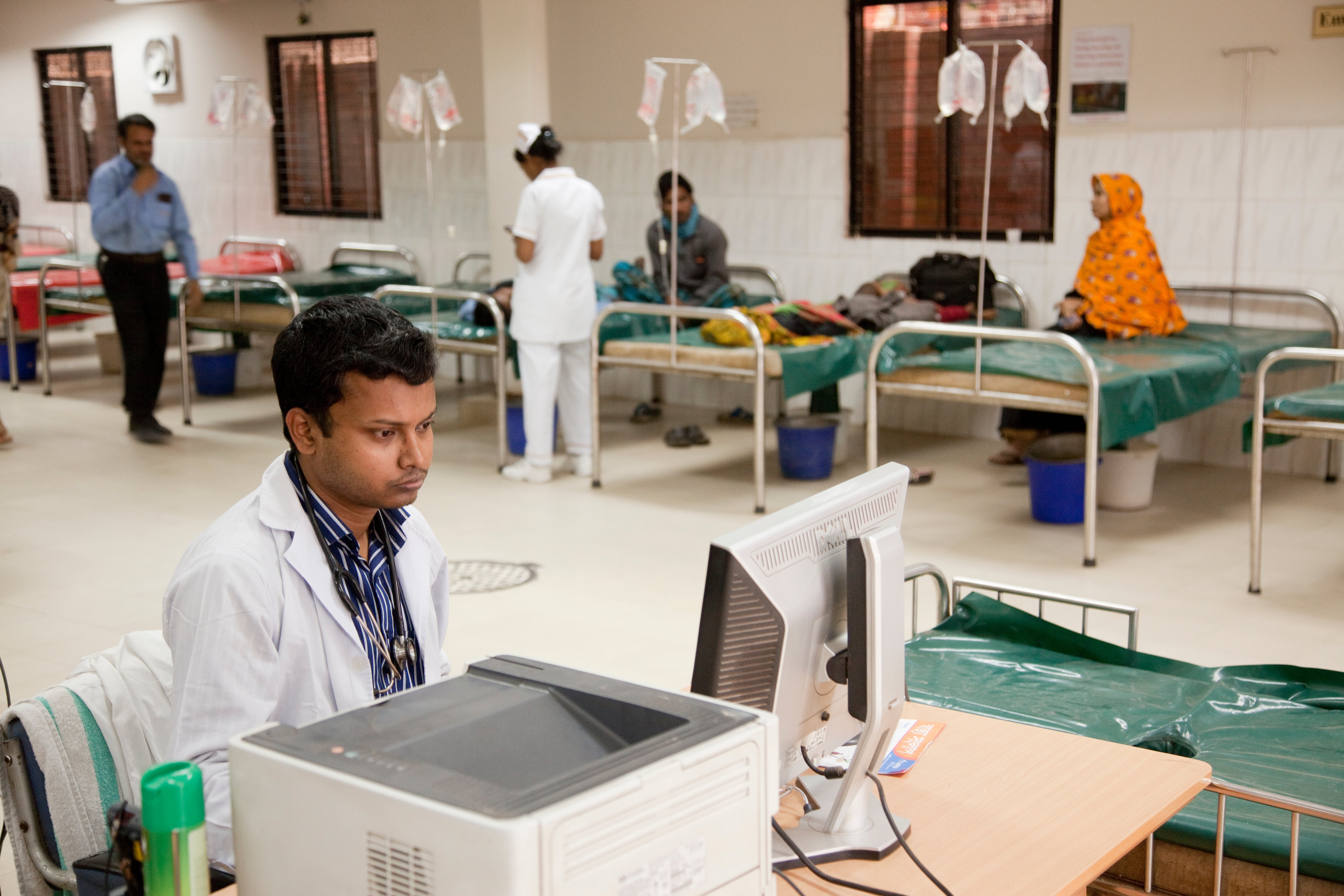Key Takeaway: By growing the health care system itself, adopting revolutionary funding schemes, and targeting vulnerable communities through pro-poor policies, Bangladesh has achieved success in reducing neonatal and maternal mortality.
Bangladesh has made neonatal and maternal mortality reduction a key goal of its public health agenda in recent decades, highlighted by several key policies that target vulnerable communities and focus on expanding access to care. This section of the narrative briefly summarizes the health care system of Bangladesh for context, then highlights selected programs that have been instrumental in reducing neonatal and maternal mortality in the country. A more complete policy timeline can be found in the Milestones section.
Health system organization and human resources
The public sector of Bangladesh’s health system plays a crucial role in the delivery of health services, particularly for maternal and newborn health. The Ministry of Health and Family Welfare (MOHFW) provides services and overall system coordination through two health service directorates, the Directorate General of Health Services and the Directorate General of Family Planning. Separately, the Ministry of Local Government, Rural Development, and Cooperatives collaborates with the MOHFW to coordinate services in urban areas. The public health landscape in Bangladesh has recently been characterized as having a spirit of collaboration, as described by one interviewee:
I have said that we work together. This practice wasn't like this before. Everybody used to work individually. It started after 2010, in the last 10 years. Before that, we never knew what UNICEF is doing, Save the children, is doing. We didn't know anything. Now we know about all the projects and have information. Directly everyone is associated with NTWC (Newborn Technical Working Committee). The Government, development partners, professional bodies, everyone is there. If you want to do anything related to neonatal activity, you need a recommendation or endorsement from this organization, then the Government's permission is required. So, everybody used to work individually at first. Now we are working together.
-Government Employee
Health care is structured according to the administrative levels of national, district (zila), subdistrict (upazila), and further to community levels. The reporting hierarchy gives the MOHFW authority over service delivery at all levels, enabling them to oversee financing, supply chain management, infrastructure, and health-workforce planning. Typically, more advanced care occurs at higher-level facilities in this hierarchy, with lower-level facilities focusing on outpatient care, essential services, and community outreach.
Community clinics—widely expanded to rural areas in 1996 and revitalized in 2009 to improve performance—reflect a high level of importance placed on primary health care in Bangladesh. Private facilities are generally concentrated in urban areas and are predominantly used by wealthier communities. Additionally, Bangladesh features a particularly strong network of nongovernmental organizations. In 2013, there were 2,252 nongovernmental organizations registered by the national government attracting donor resources, which the Bangladeshi government links to its health care system via extensive public–private partnerships.
Figure 22: Health Service Delivery Organizational Structure in Bangladesh

Regional Office for the Western Pacific. (2015). Bangladesh health system review. Health systems in transition, 5 (3), WHO Regional Office for the Western Pacific. https://apps.who.int/iris/handle/10665/208214

Expansion of health care facilities has translated to increased access to care. This trend, as well as increased healthcare utilization, was highlighted by one interviewee:
The services are available now. The patient who has simple complications can seek service from a nearer center. People’s faith in service has increased. The tendency of going to the hospital has increased among people. They prefer to go to those hospitals which consist of newborn services. This interest has increased, and the change is quite visible.
-Government Employee
The proliferation of healthcare facilities in Bangladesh is well documented. In 2001, 74% of women could reach a public or private health facility within one hour. By 2016, all women lived within one hour of a health facility. Improved access has been particularly notable for private facilities, increasing from 20% of women living within one hour in 2001 to 91% in 2016.,
Figure 22: Access to Health Facilities within 1 Hour in Bangladesh

International Centre for Diarrhoeal Disease Research, Bangladesh (icddr,b), and MEASURE Evaluation. (2019). Bangladesh Maternal Mortality and Health Care Survey 2016: Final Report. Dhaka, Bangladesh, and Chapel Hill, NC, USA: NIPORT, icddr,b, and MEASURE Evaluation.
The number of nurses and midwives in Bangladesh increased from 37,233 in 2001 to 63,857 by 2019, a growth level that outpaced the population increase, leading to a slightly increased density of nurse and midwives., The number of doctors in Bangladesh increased even more substantially, from 32,498 in 2001 to 103,809 by 2019, as the physician density increased over 250%., This rapid rise is in part due to the expansion of training institutions as 44 private medical colleges were established by 2011, despite none existing in 1996. Many private practitioners are clustered in urban areas, whereas a network of alternative care providers that rely on traditional beliefs and homeopathic approaches exist in poorer, rural areas.
Figure 24: Healthcare Worker Density in Bangladesh from 2001 to 2020

Available from https://www.who.int/data/gho/data/themes/topics/health-workforce. (Accessed 17 November 2022)

Family planning action plan
In 1977 the International Centre for Diarrhoeal Disease Research, Bangladesh, launched an innovative program aimed at promoting uptake of family planning. This project began in the rural subdistrict/upazila of Matlab, where certain “treatment” villages were given improved access to family planning via female community health workers. Consultations enabled conversations between women and community health workers about different methods and personal preferences. This approach of delivering family planning information and resources to women directly in their homes was revolutionary at the time.
Within only a few years, the impact on fertility and health outcomes was evident, leading to a rapid government scale-up of this approach outside of Matlab. This approach led by female community health workers has led the family planning program in Bangladesh to be one of the most successful in the world, reducing the country’s total fertility rate from 6.9 live births per woman in 1970 to 2.0 live births per woman in 2019.
Pharmaceutical development
One of the most innovative features of the health care system in Bangladesh began with the National Drug Policy of 1982 that facilitated widespread access of essential medicines. This piece of legislation, a landmark policy at the time, positioned Bangladesh as the only low-income country to develop its own pharmaceutical industry. The policy began with an essential list of generic drugs drafted through consultation with high-level government officials, practitioners, multilateral organizations such as the World Health Organization, and industry leaders. The government then allowed domestic pharmaceutical firms to competitively purchase raw materials from more advanced markets and establish transparent pricing structures.
The MOHFW created a separate entity for regulating this process, the Essential Drugs Company, which oversaw quality and supply. This program imported the majority of required raw materials, but exported only 1.1% of manufactured drugs, indicating a high degree of domestic consumption.
In 2019, Bangladesh met 97% of its demand for medicines through domestic manufacturing, with the remaining 3% being advanced treatments and new vaccines. Although some issues surround the proliferation of private retail pharmacies, supply chain logistics, and associated out-of-pocket costs, the National Drug Policy has remarkably improved access to drugs in Bangladesh and has left the country less prone to stockouts of essential drugs for safe delivery than many of its peers.
Female Secondary School Stipend and Assistance Program
In 1994, the government of Bangladesh established the Female Secondary School Stipend and Assistance Program to boost secondary school enrollment among women and encourage delayed marriage. This conditional cash-transfer program consists of a uniform stipend and a tuition subsidy for girls attending secondary school in rural areas. To qualify, girls must attend school 75% of days, attain test scores above the 45th percentile, and remain unwed until passing the final secondary school exam. This program supports over 2 million girls each year and has been linked to delays in marriage. The Female Secondary School Stipend and Assistance Program has additionally been shown to improve male education rates through sibling spillover. The benefits of this program have been determined to outweigh the costs by more than 200%, powerfully demonstrating the impact that social and upstream programs can have on health in vulnerable communities.
Sector-wide approach for health
Bangladesh’s sector-wide approach (SWAp) program has been specifically praised by researchers for what one referred to as its “predominant focus on maternal and child health” and family planning. Moreover, key advances in maternal and newborn health, such as the revitalization of community clinics, have been enabled by the SWAp.
This innovative financing and management mechanism was supported by organizations including the World Bank; the Global Fund; Gavi, the Vaccine Alliance; the United Nations Population Fund; the United Nations Children’s Fund; and the governments of Canada, Germany, Japan, the Netherlands, Sweden, the United Kingdom, and the United States.
Before 1998, the MOHFW operated vertically with development partners on specific projects, leading to duplications of work and logistical inefficiencies. With the implementation of the SWAp program, 128 separate projects were replaced in an effort to improve essential service provision, with a large focus on maternal, neonatal, and reproductive health. Over time, the MOHFW has gained more control over the SWAp program in relation to development partners, in part due to strong performance during key review periods. A series of SWAp programs in Bangladesh have each had slightly different areas of focus, but all share the same general goal of improving access to an essential package of health services, particularly among women, children, and vulnerable communities. The SWAp programs have been heralded as a key factor in improving supply chain management, strengthening monitoring and evaluation infrastructure, and promoting local ownership of the health care system.
Figure 25: Overview of SWAp (Sector Wide Approach) Programs in Bangladesh

Ahsan, Karar Zunaid, et al. "Fifteen years of sector-wide approach (SWAp) in Bangladesh health sector: an assessment of progress." Health Policy and Planning 31.5 (2016): 612-623.
Maternal Health Voucher Scheme
Established in 2007, the Maternal Health Voucher Scheme aims to reduce financial and physical barriers to care for women with lower income. This demand-side financing scheme operates in 53 of the poorest subdistricts/upazilas, which were chosen for their low literacy rates, high poverty levels, and density of community-based skilled birth attendants. Enrollment occurs through female health assistants and female welfare assistants who identify women in their first month of pregnancy. Eligible women qualify for three antenatal care visits and the cost of delivering at a health facility, including medically necessary cesarean section (C-sections), medicines, cash allowances for transportation, and a cash incentive for delivering at a health facility. Providers are reimbursed for each service delivered, with both public-sector and private-sector entities eligible to accept the vouchers. Upon approval by program officials, local banks issue full reimbursements to private providers while public providers split their reimbursement with a seed fund for health facility maintenance. Evidence suggests that this program has improved coverage of antenatal care, facility-based delivery, and postnatal care for eligible women.
Figure 26: Maternal Health Voucher Scheme (MHVS) in Bangladesh

Mahmood, Shehrin Shaila, et al. "Does healthcare voucher provision improve utilisation in the continuum of maternal care for poor pregnant women? Experience from Bangladesh." Global health action 12.1 (2019): 1701324.
Health information systems
Bangladesh has one of the strongest data collection systems on maternal and newborn health among low- and middle-income countries. Between 1990 and 2019, the country implemented 19 national household surveys that measure maternal and newborn health—eight administrations of the Demographic and Health Surveys, five of the Multiple Indicator Cluster Surveys, three of the Bangladesh Maternal Mortality and Health Care Surveys, and three of the Service Provision Assessments.
Bangladesh is the only low- and middle-income country that has implemented three large surveys to measure maternal mortality and specific causes of death. It is also the only country that includes a child cause-of-death data module in the Demographic and Health Surveys. The wealth of data collected in Bangladesh is tabulated in annual statistical reports or yearbooks by the Bangladesh Bureau of Statistics.
Bangladesh also boasts a Maternal and Perinatal Death Surveillance and Response system in 48 districts covering two-thirds of the country’s population. This program, implemented by the MOHFW, aims to determine the medical and social causes of maternal, neonatal, and stillbirth deaths through verbal and social autopsies and facility death review. Through this approach, Bangladesh aims to correct any issues in a targeted fashion to avoid repeated mistakes.

